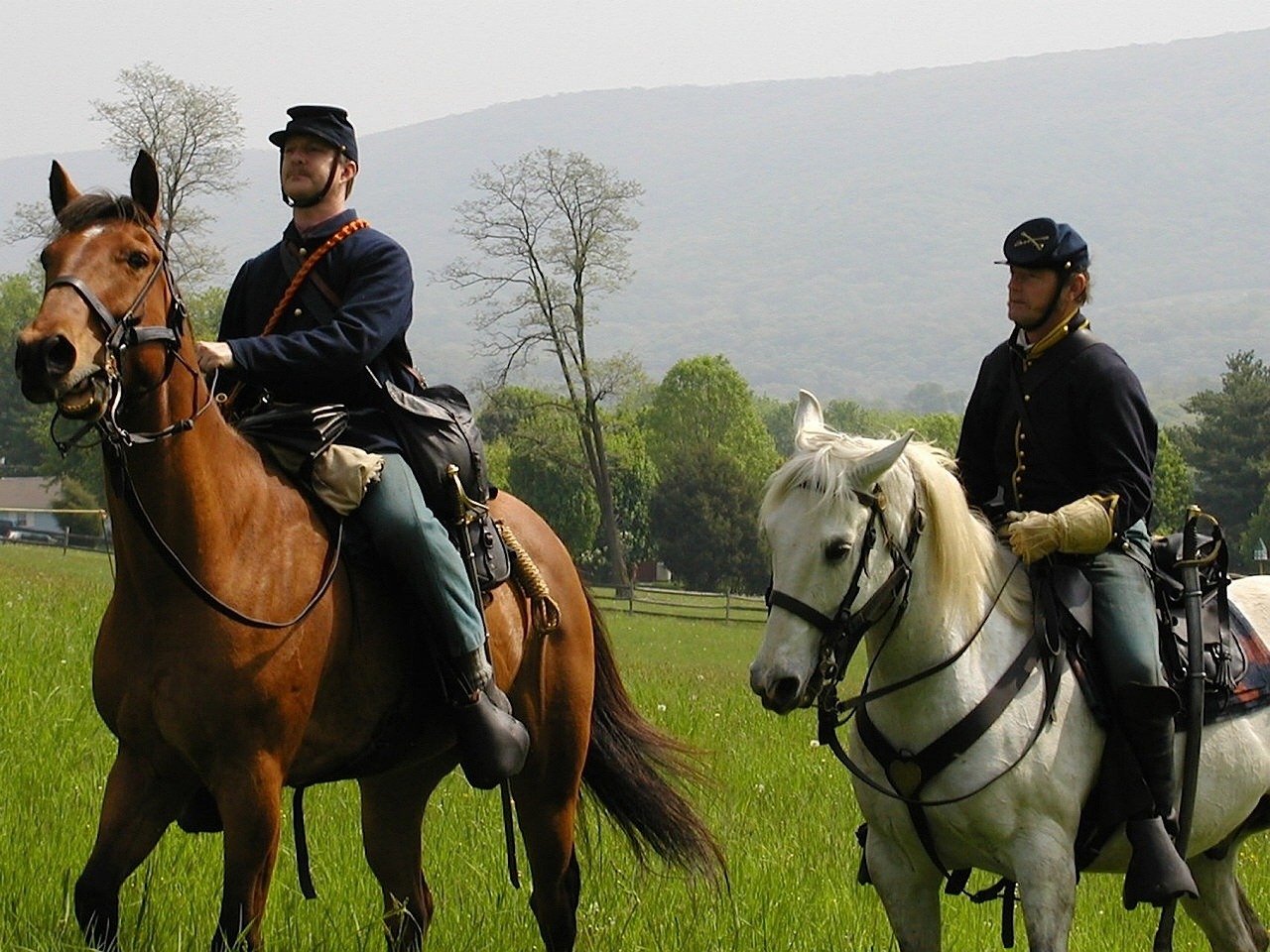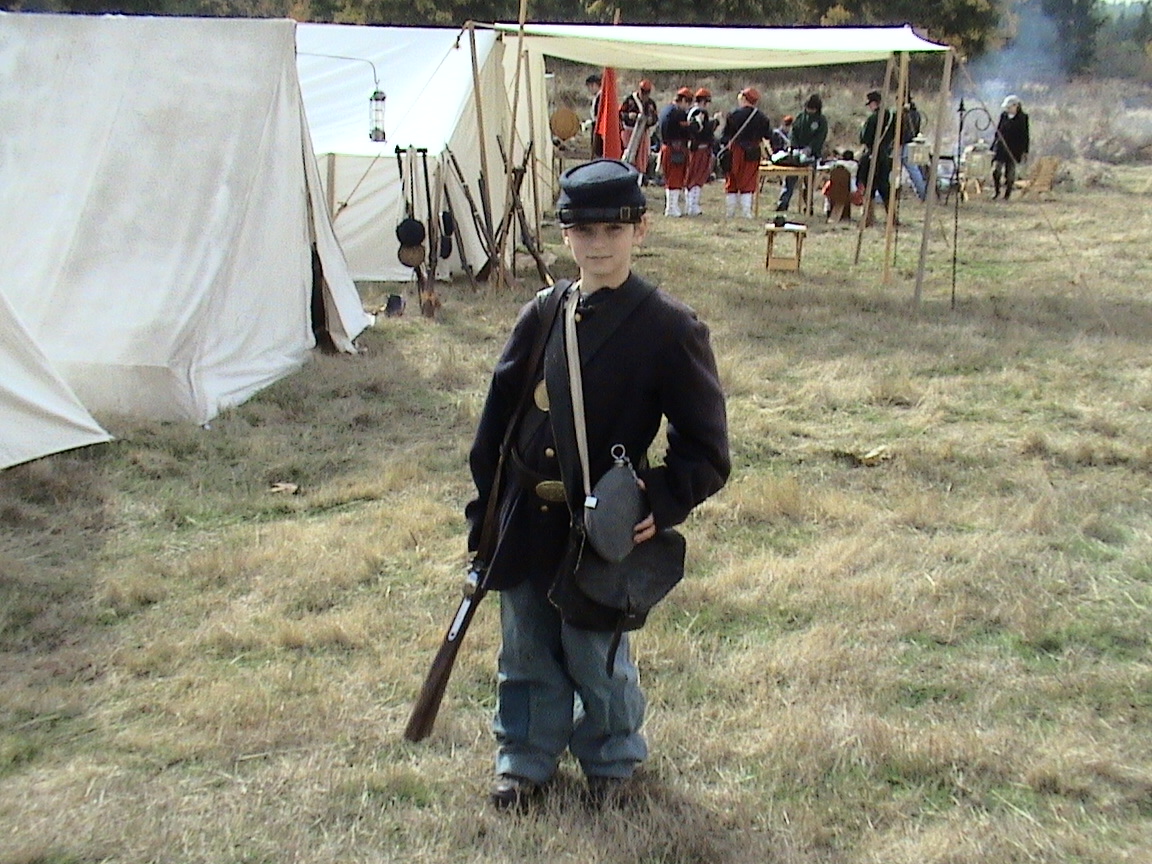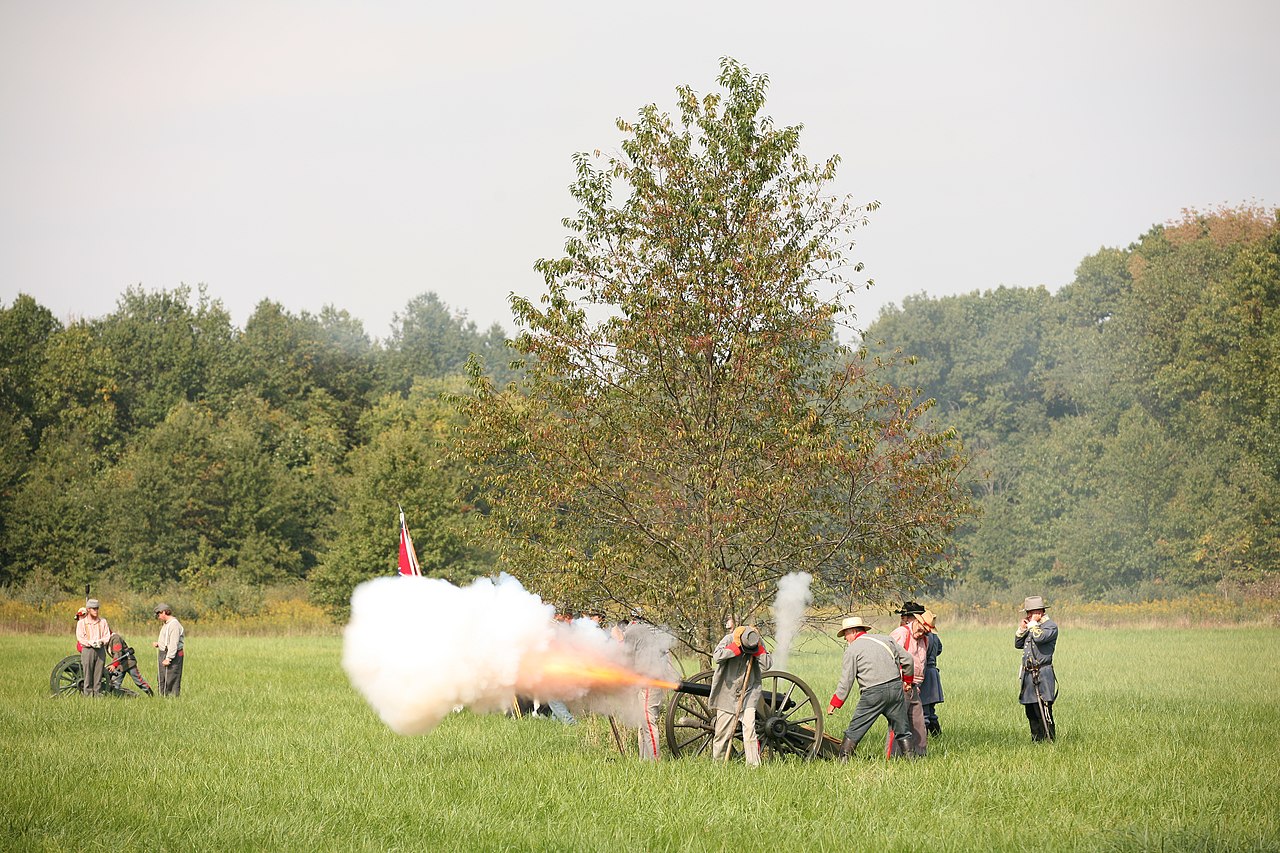A popular pastime in the United States, Living History comprises dress-up with a keen eye for detail, deep historical research, and a hearty sense of camaraderie. Tens of thousands of Americans take part in reviving the past through historical recreations and Living History events. Here, three Living Historians explore the “why” behind the devotion and dedication they pour into their passion. They also explain distinctions within the hobby and its structure.
◊
“There were a lot of moments where you actually would pass through time and you would be there in the moment.” — Brian Buntain, Living Historian
We Americans love our hobbies. As much time as we dedicate to our working lives, we also take our spare time seriously. We compete at sports, do crossword puzzles, and play video games. We hike, collect stamps and coins, and generally enjoy being active with engaging pastimes. These are all fine hobbies, but consider another activity that takes us deep into the American story. This pastime allows enthusiasts to relive eras of the past and restage critical moments in U.S. history as re-enactors and Living Historians.

Civil War reenactors
(Image courtesy of 12019, via Pixabay)
Living History is an avocation that’s been around since at least the beginning of the 20th century. It is popular around the world, with many medieval re-creations in Germany and throughout Europe, and is particularly widespread in the United States. Many U.S. enthusiasts recall the American Bicentennial of 1976 as a key moment for the hobby, with associations sprouting up all across the nation to commemorate the event. And at least since the U.S. Civil War's centennial in the mid-1960s, Civil War buffs have gathered in historical locations to re-enact key moments in the conflict with as much authenticity as they can muster.
What Are Re-enactors and Living Historians?
All across the U.S. (particularly in the East and Northeast) are sites that played historic roles in the creation and development of America. Among them are places like Gettysburg and Williamsburg. Historical events of note — a site of a great military battle, or a successful colonial outpost — attract visitors and amateur historians with an interest in the development of the country.
This led to historical re-enactments of events ranging from daily life in a past era to critical battles, say, from Revolutionary or Civil War eras. Re-enactors take part in the events, including mock battles and other military maneuvers, while Living Historians take responsibility for interpreting the activities onsite for visitors, often assuming the roles of historical figures speaking from the specific time and place.
Listening to these Living Historians, the distinction between historical re-enactors and those who take part in Living History becomes clearer. “It’s not one and the same,” explains Michael Schwendau. “The way to distinguish the two is, you’ll have people who . . . go to Living History events, and they have very minimal skill sets – they only do what they’re told. Living Historians, for example, make their fire like I used to, using flint and steel.” Living Historians, he concluded, “start learning the skills.”
Click to stream "The Spirit of the Pony Express."
Learning about Living History from its Enthusiasts
I recently had the opportunity to speak with Living Historians from different parts of the U.S. Their interests spread across distinct, separate historical periods. They’ve been generous with their time so we can get a sense of what they do, what inspires them to do it, and how their historical interests show up in their daily lives.
- Matthew Mees, from Massachusetts, involves himself with the oldest period of the three. He specializes in Colonial life of the late 18th century, from British rule to the early years of independence.
- Michael Schwendau, from Kentucky, has a deep and abiding interest in the wars of early America. His activities start in the 1750s with the French and Indian War and range up to the War of 1812, with which he is particularly fascinated.
- Brian Buntain, from Washington State, possesses a vast historical understanding of several eras, from the East Coast to the West, encompassing the Civil War to the homesteaders who followed the Oregon Trail, all from the mid-19th century.
What Do Living Historians Do?
I asked each of these Living Historians to explain what their activities include. Interestingly, all portray figures from a variety of periods. Michael says, “I do/did two types of impressions.” In one he assumes the role of an infantryman or militiaman in recreations of late 18th century provincial and frontier life. In the other, as a culinary expert, he becomes a Royal Navy ship’s cook. Of the latter, he points out, “I prepared period foods using [period-authentic] methods and ingredients as much as possible.”
Brian explains, “The War between the States is basically what I am most active in. The War between the States and, more specifically, Mosby’s Rangers.”
Mosby’s Rangers were a band of Civil War-era cavalrymen who fought for the Confederacy. Under the leadership of the charismatic John S. Mosby, who reported directly to Robert E. Lee, they were active from 1863 to 1865 and disbanded shortly after Lee surrendered to end the war.
I was intrigued to find out what interests or inspirations led them to take up Living History as a hobby. Michael was fascinated by events he attended, and he decided to become a participant in events near his home. For Matthew and Brian, it started much earlier. Matthew explains that he became interested in the past when he was only five years old. And Brian remembers movie serials from his childhood: “I started young. When I was a little kid, Saturday mornings I looked forward to the next episode of The Grey Ghost. It was all about Mosby.”

Young Civil War reenactor
(Image courtesy of D. Farr, via Wikimedia Commons)
Women Have a Role in Role-Playing
While historical re-creations are primarily attended by men, there have also been roles for women since Living History events first came on the scene in the mid- to late-20th century. Matthew explains, “The role of women has evolved. There have always been women who dressed as men, [but] women in the ranks has always been more controversial, especially when they do not develop the beer gut that so many men produce,” he joked.
Michael adds, “On occasion there were women that would bend gender to participate as men in the companies. This often took them to doing makeup and bindings to hide the female form as much as possible. But they participate as men in the company without complaint.”
Brian supplies more detail. “We had a re-enactment group, Mosby’s Rangers, here in Washington State. In consideration for historical accuracy, our women members did not ride with us on the battlefield. In our public encampments, the women would write letters, and we would do scenarios where they would read letters or period newspapers, and talk with us about things going on in the war and at home.” He continues, “But at our monthly drills when we would go out on the trail, out in the woods, the women would ride with us. Our research never revealed a woman riding a mission with the Rangers. At an event, our female members would portray an accurate role for the time period. For us, that was so important.”
Traveling through Time to Capture an Experience
There is a thrill to Living History events that seems vital to all my interview subjects. But how to put that thrill into words? Here, Brian offers a strong metaphor: “There were a lot of moments where you actually would pass through time and you would be there in the moment. And that was what we all strived for. . . . It was about being in the moment, and it was about traveling through time to capture that experience.”
Michael says, “Living Historians have that spark of curiosity.” And Matthew tells a similar tale, referring to his participation in events as a “regular time travel experience.” He adds that when he and his family visited Ticonderoga “for what was then the annual French and Indian War event . . . I was wandering through the marketplace, hearing as much French as English spoken, men in full battle kilts, naked savages painted red and black, and I honestly could not tell you where I was or when.”
Historical re-enactments, and the societies and groups that present them, are not limited to the U.S. and its military history. There are groups all over the world recreating events from all throughout history, from medieval times in Slovenia to the Korean War in South Korea.
Bringing the Past into Contemporary Life
When I asked them what, if anything, they might use in their daily life that they learned doing Living History events, each of them supplied colorful answers. Brian’s was perhaps the most profound. He simply said, “I try to live by a code of honor. Back then both sides had a code of honor . . . honor was so important then.”




(Image courtesy of Daniel Schwen,
via Wikimedia Commons)
Michael responded, “I think the idea of simple and handmade processes are more productive than ‘hurry-up.’ Life was more deliberate, or seems to have been so.” He goes on to say, “I still prefer to drink my coffee out of my walnut noggin or tin rather than my desk mug,” and concludes with a very telling remark: “It’s difficult for me to say where it starts and ends or which is influencing which.”
Matthew continues, “This [my Living History experience] is always running in the background and provides a filter through which I view the world.” He added, “I understand [for example], perhaps better than they do, why Canada is upset with the U.S.”
Distinguishing Among Participants
One of the terms of art, so to speak, for re-enactors and Living Historians, is farby, which refers to re-enactors whose self-presentation fails to measure up to the more exacting standards of more discerning participants. Brian offered an instructive summary of how farby developed its meaning:
“I started out as a re-enactor and at first I was amused, thinking it’s pretty silly for these guys, running around in the woods, shooting guns with no bullets. The difference basically is a re-enactor is not so much interested in the history aspect . . . they’re more interested in the action, and they like dressing up in the clothes, and they’re not so interested in detail. . . . Farby came about because of re-enactors who really became interested in doing things right, and going for the moment where you pass through time, and anything that would detract from that, like any modern anachronism, would be something that would ruin the moment. And so, at the same time, you didn’t want to disparage another re-enactor, but you would say, ‘Far be it for me to . . . say bad things about your presentation. However, you have anachronisms here that are detracting from my experience,’ and that got shortened down to farby.”
Michael says, “I believe the term to be a derogatory one. Basically means they aren’t up to a person’s snuff or they are not at the level others are at. People who apply it are elitist and well established in the hobby. Instead of identifying the person as someone who could use some help, they often ridicule them and make fun. Which ends up turning them off and more often than not quitting the hobby.” Matthew diplomatically says, “The concept of correct material culture has divided the hobby, generally along generational lines.”
Bringing the Past Alive with Living History
There are even distinctions within the world of Living Historians, and Brian explicated these gradations as well. “There’s different levels of Living History. There’s first-person interpretation and there’s third-person interpretation. Third-person is where you are your modern self but you are in proper attire . . . and you talk to the audience and say ‘This is how they did things.’ The ultimate level is to do first-person, and [with that] you have to stay in character . . . and you have to think through that character first.” He summarizes by saying, “The important part for doing first-person interpretation is, you need to have the base [of period knowledge] to draw from.”
Despite some internal politics, as all large organizations of diverse people have, it’s possible to feel the excitement that these three Living Historians share for the pastime. Each of them emphasized the thrill of feeling like they’d been transported to a different place and time in the best of their experiences.
Unlike a science-fiction/fantasy role-playing game like Dungeons & Dragons, Living History is a hobby that draws on actual historical events. I’d go so far as to say it makes U.S. history fun, and even inspirational. And that’s something more typical American hobbies are less able to offer.
I’d like to thank my interview subjects for their time and patience in addressing my questions: to Brian Buntain, Matthew Mees, and Michael Schwendau, my deep appreciation.
Ω
Kevin Martin is Senior Writer for MagellanTV. He writes on a wide variety of topics, including outer space, the fine arts, and modern history. He has had a long career as a journalist and communications specialist with both nonprofit and for-profit organizations. He resides in Glendale, California.
Title image: Civil War Reenactment in Four Oaks, NC (Bentonville Battleground) by user shafman via Pixabay.

